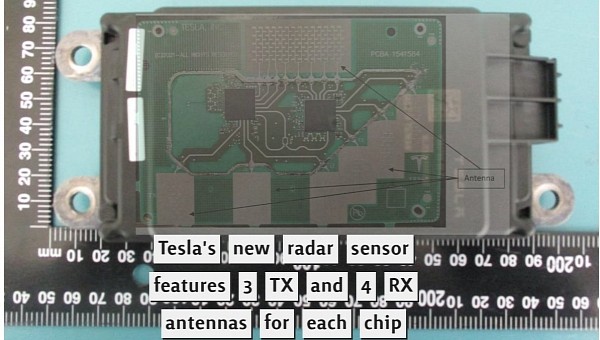Tesla reversed the controversial decision of ditching radar sensors on its vehicles. According to the latest information, the Hardware 4 FSD computer and sensor suite include a radar sensor. Nevertheless, despite being rumored as a high-resolution imaging radar, the new component seems more like a glorified adaptive cruise control radar.
We're already accustomed to Tesla pretending its most bizarre decisions were motivated by facts and logic, only to reverse them later. Not with an "I'm sorry, we were wrong, it was better before," but with a "this is a new way, 1,000 times better." Even when, in fact, it was the same soup, only slightly warmed up. That's why we weren't surprised when the first rumors about a new radar sensor surfaced last year.
What surprises us is that Tesla dropped the radar sensors in 2021, all while working on a new radar sensor since at least 2020. Even stranger is that the "new" radar sensor that comes with the HW4 sensor suite features PCB and hardware from 2021, as revealed in the first pictures extracted from the FCC website. And even more bizarre, experts analyzing the radar documentation think this is not the imaging radar Tesla talked about but just a souped-up sensor, probably superior to the previous solution, but not by much.
According to the FCC documents, the new radar sensor is a "non-pulsed Automotive Radar which operates in the 76-77 GHz spectrum and supports 3 sensing modes." Given its relatively narrow field of view and the fact that it will be integrated behind the bumper in exactly the same position as before 2021, it could probably be useful for detecting objects in close proximity to the car.
The pictures of the radar's internals reveal that the radar unit does not differ significantly from other automotive radars. The main chip controlling the radar is a Xilinx Zynq, a programmable and rather expensive component better suited for prototypes and low-volume production. This option suggests that Tesla is still working on the radar component and needs this characteristic to further tweak the radar functionality. In all fairness, FPGA (Field Programmable Gate Arrays) chips also offer a "massive amount of bandwidth and excel at parallel tasks," as one FPGA engineer revealed.
According to another engineer with experience in radar sensors, Tesla's new sensor is a better version of the Bosch/Continental radar used before. Its higher working frequency and superior raw data capabilities help identify objects and measure distances better, but it cannot perform magic. Although not radically different from an adaptive cruise radar, Tesla could leverage the firmware to better interpret the raw data and offer a better outcome.
The wildcard here is how Tesla would combine and process the information from the radar and the other sensors to offer a better image of the road. The radar can detect objects in front of the car, but it has no idea whether the car's path intersects with the detected objects. The radar has no idea if the road takes a turn before that, although the vision-based perception knows. That's why you can still experience phantom braking in a legacy car that relies on the radar sensor or poor camera to offer driver-assist features. Hopefully, Tesla will sort things out and better communicate on the matter.
What surprises us is that Tesla dropped the radar sensors in 2021, all while working on a new radar sensor since at least 2020. Even stranger is that the "new" radar sensor that comes with the HW4 sensor suite features PCB and hardware from 2021, as revealed in the first pictures extracted from the FCC website. And even more bizarre, experts analyzing the radar documentation think this is not the imaging radar Tesla talked about but just a souped-up sensor, probably superior to the previous solution, but not by much.
According to the FCC documents, the new radar sensor is a "non-pulsed Automotive Radar which operates in the 76-77 GHz spectrum and supports 3 sensing modes." Given its relatively narrow field of view and the fact that it will be integrated behind the bumper in exactly the same position as before 2021, it could probably be useful for detecting objects in close proximity to the car.
The pictures of the radar's internals reveal that the radar unit does not differ significantly from other automotive radars. The main chip controlling the radar is a Xilinx Zynq, a programmable and rather expensive component better suited for prototypes and low-volume production. This option suggests that Tesla is still working on the radar component and needs this characteristic to further tweak the radar functionality. In all fairness, FPGA (Field Programmable Gate Arrays) chips also offer a "massive amount of bandwidth and excel at parallel tasks," as one FPGA engineer revealed.
According to another engineer with experience in radar sensors, Tesla's new sensor is a better version of the Bosch/Continental radar used before. Its higher working frequency and superior raw data capabilities help identify objects and measure distances better, but it cannot perform magic. Although not radically different from an adaptive cruise radar, Tesla could leverage the firmware to better interpret the raw data and offer a better outcome.
The wildcard here is how Tesla would combine and process the information from the radar and the other sensors to offer a better image of the road. The radar can detect objects in front of the car, but it has no idea whether the car's path intersects with the detected objects. The radar has no idea if the road takes a turn before that, although the vision-based perception knows. That's why you can still experience phantom braking in a legacy car that relies on the radar sensor or poor camera to offer driver-assist features. Hopefully, Tesla will sort things out and better communicate on the matter.








